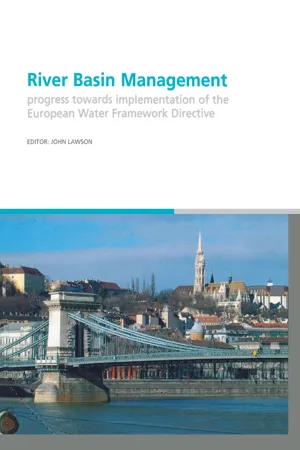
River Basin Management
Progress Towards Implementation of the European Water Framework Directive
- 396 pages
- English
- ePUB (mobile friendly)
- Available on iOS & Android
River Basin Management
Progress Towards Implementation of the European Water Framework Directive
About this book
River Basin Management is a collection of papers presented at a conference on implementation of the EU Water Framework Directive, held in Budapest in May 2005. The Water Framework Directive requires progressive protection and enhancement to rivers, lakes, estuaries, coastal waters and wetlands by the year 2015. At the heart of this major new piece of legislation is the requirement for all EU member states to prepare river basin management plans for all river basin catchments, providing the basis for coordinated improvements to water management, leading to better water quality and sustainable aquatic environments in lakes and rivers. The papers cover a wide range of topics including pilot studies for the development of river basin management plans, public participation in the planning process, water quality monitoring, modeling and analysis, identifying and addressing pollution and meeting environmental objectives. The book presents an array of experience from eighteen European countries in the implementation of the EU's most far reaching environmental legislation. It is an invaluable source of information and ideas for the widespread preparation of river basin management plans now starting throughout Europe.
Frequently asked questions
- Essential is ideal for learners and professionals who enjoy exploring a wide range of subjects. Access the Essential Library with 800,000+ trusted titles and best-sellers across business, personal growth, and the humanities. Includes unlimited reading time and Standard Read Aloud voice.
- Complete: Perfect for advanced learners and researchers needing full, unrestricted access. Unlock 1.4M+ books across hundreds of subjects, including academic and specialized titles. The Complete Plan also includes advanced features like Premium Read Aloud and Research Assistant.
Please note we cannot support devices running on iOS 13 and Android 7 or earlier. Learn more about using the app.
Information
Comparative assessment of nutrient fluxes in five medium size European river catchments
Institute for Water Quality and Waste Management, Vienna University of Technology, Austria
Department of System Ecology, University of Bucharest, Romania
Department of Sanitary and Environmental Engineering, Budapest University of Technology and Economics, Hungary
Institute for Water Quality and Waste Management, Vienna University of Technology, Austria
1 INTRODUCTION
1.1 The daNUbs-project
- even if river quality standards are met, nutrients may still have a strong effect on the marine coastal areas and result in eutrophication;
- pollution from both diffused and point sources is important;
- the nutrient storage in the catchment (soil, groundwater etc. ) is orders of magnitude higher than the yearly nutrient turnover;
- the entire population is c...
Table of contents
- Cover
- Half Title
- Title Page
- Copyright Page
- Table of Contents
- Organising Committee
- International Technical Committee
- River basin management planning
- Implementation of the European Water Framework Directive in national legislation of the Czech Republic (progress to date)
- The implementation of the WFD in Austria - first results and future field of actions
- Shannon River Basin District Project
- Managing water resources in a European semi-arid environment: drinking water production in the Barcelona's metropolitan area
- The next step: integrating economics into Water Framework Directive programmes of measures
- Pilot studies
- Implementation of the Water Framework Directive for Matsalu Sub-River Basin District, Estonia
- River basin management planning in the Czech Republic (the upper and middle Elbe River Basin district illustration)
- Catchment management within the Murray-Darling Basin in Australia
- Integrated lake/catchment approach as a basis for the implementation of the WFD in Lake Pusiano watershed
- Ribble Pilot - lessons learned from the UK
- Monitoring, modelling and analysis
- Impact monitoring at the Danube using in-line sensors
- The assessment of groundwater chemical status and modelling of agriculture pressures
- Tools for groundwater and surface water analysis during implementation of the Water Framework Directive in Lithuania
- Application of a distributed watershed model to water quality computation in the Nummenjoki catchment
- Paper integrated modelling of rivers and washlands to meet conservation objectives - a case study
- Sustainable river basin management: a dynamic model
- Comparative assessment of nutrient fluxes in five medium size European river catchments
- Development of links with monitoring organisations from upper Riparian states in the former Soviet Union: experiences from the Joint River Management Programme
- Zagyva-Tarna: early results from the Hungarian WFD pilot
- Identifying and addressing pollution
- Integrated model for nitrate loads to coastal waters applied in catchment scale water management
- Towards the implementation of the Dangerous Substances Directive in Hungary: a case study on the Atáler river
- Future development of nutrient emissions and river loads in the Danube Basin
- Integrated water management in former coal mining regions (INWATCO)
- Approaches to quantification of pollution load and response in the Kapos catchment (AQUAPOL)
- Water Framework Directive - managing urban run-off at source
- Environmental objectives
- Relationships between ecological status of surface waters and both chemical and hydromorphological pressures
- Environmental factors affecting benthic macroinvertebrate fauna in small and mid-sized calcareous lowland streams in Greece
- A novel approach of river water quality characterization
- International aspects of WFD implementation in the Danube River Basin
- Posters
- Using research knowledge to implement the Water Framework Directive
- First delineation of surface water bodies in Slovenia
- Integrated testing of Water Framework Directive GIS Guidance Document on the Szamos/Somes River Basin
- Creating a portal for stakeholder engagement in the Water Framework Directive
- ECOSURV: a WFD ecological survey of surface waters in Hungary
- Assessment of river water quality through method of bioindication (as Araks river exampie)
- Integrating one- and two-dimensional hydrodynamic models for flood simulation
- Author index